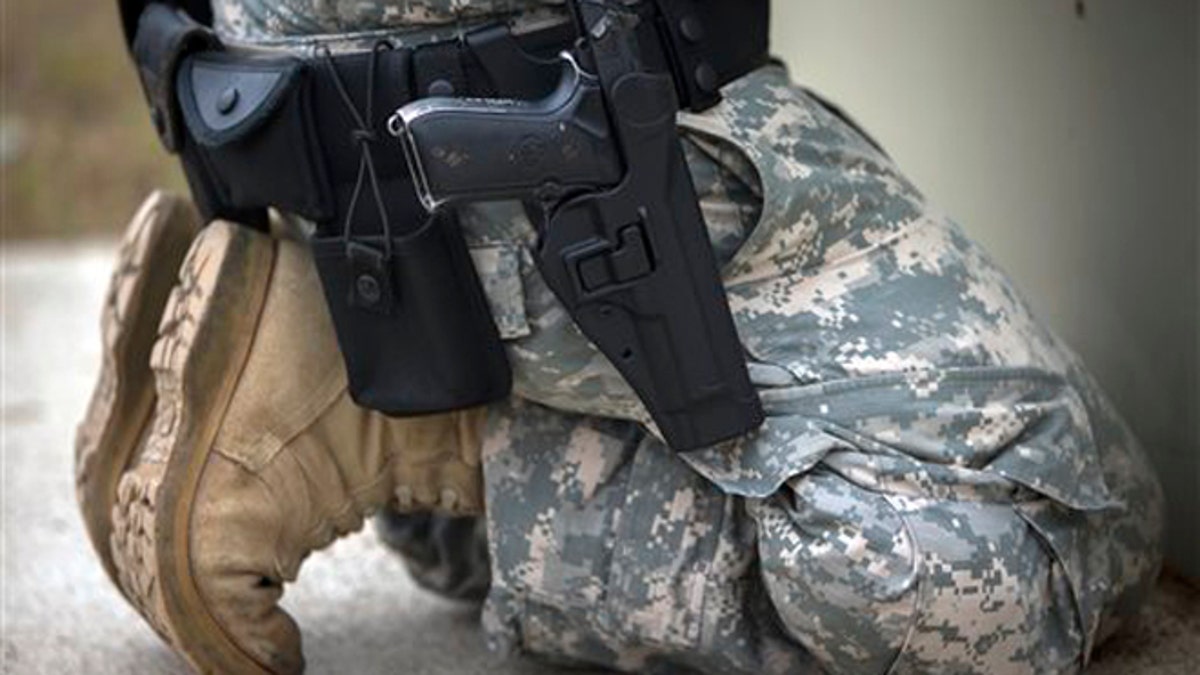
Sept. 29, 2015: A member of the 139th Military Police Company kneels with his holstered 9mm Beretta M9 during a qualifying exercise at a small arms range in Fort Stewart, Ga. (AP Photo/Stephen B. Morton)
FORT STEWART, Ga. – Firearms manufacturers are competing for a rare chance to sell the U.S. Army a new handgun that would replace its current Cold War-era model, and they must meet a lengthy list of requirements to win the lucrative deal.
The Army wants an easier-to-shoot handgun that can inflict more damage on enemies, and the contract will be worth up to $580 million. The winning gun-maker also gets a tacit stamp of approval that could attract sales from other military forces and boost its popularity in the civilian firearms market.
The Army's main handgun — the M9 — is a 9mm semi-automatic intended as a last-ditch, defensive weapon. It was first issued in 1985, and critics say it's too bulky for small-handed shooters. Troops who fought in Iraq and Afghanistan complain it's not as hard-hitting as they would like. And it can't easily accommodate the accessories now common in the civilian firearms market, such as swappable gun-sights or gun-mounted lights.
"It's a little one size-fits-most, and not everybody is one size," said Rodney Briggs, a firearms instructor and former military policeman in the Army National Guard. He carried the M9 during two tours of duty in Iraq. "It's been around for a really, really long time, and it's just old and outdated."
The M9 — and eventually, its successor — is generally carried by soldiers with duties that would make it impractical to lug around a rifle or carbine. That group includes senior officers, tankers, pilots, or those assigned to team-operated weapons.
Rather than tweaking its M9, manufactured by Beretta USA Corp., the Army decided it would be more economical to replace both the M9 and the smaller M11 with the new gun. The new weapon will likely be adopted by other services, too.
"If you're driving an old, beat-up Chevy, you're spending more money than you'd spend on a new car payment," said Daryl Easlick, a civilian who works at Fort Benning in Georgia and develops weapons meant for up-close fighting.
The Army has a lengthy list of requirements. Among them, it wants a handgun with an adjustable grip that can easily fit large or small hands. That way, shooters don't have to adjust their grip mid-fight to operate hard-to-reach buttons or levers.
"I have to overlap my hands" around the M9's fat grip, said Pfc. Elizabeth Reabuck, a member of the Army's 139th Military Police Company, which was training recently with the M9 on a firearms range at Fort Stewart. "If I had to shoot one-handed with this thing, it wouldn't go very well."
The gun should accommodate sights that make it easier to shoot in low light. It should have a rail on which soldiers can easily attach additional equipment, like infrared pointers. The military also wants a gun that can be equipped with a suppressor, which muffles the sound of gunshots.
A 2006 survey found that 58 percent of soldiers who returned from combat reported being satisfied with the M9 pistol, a low score compared with the 75 percent satisfaction rating for the M16 rifle and 89 percent for the M4 carbine. Roughly a quarter of soldiers said they wanted a weapon that used a bigger bullet that could more easily stop an enemy.
Like some of those in the survey, Sgt. Gary Tillery said he would ideally like a more powerful handgun. Between his time in the Marines and the Army, Tillery served four tours in Iraq and one in Afghanistan and was deployed to Qatar.
"I own several handguns, and I prefer a higher caliber. I like the stopping power," said Tillery, who was also qualifying at the Fort Stewart range. "I've seen people take a few hits and keep coming. If I have to draw my gun and use it, I want them to stop immediately."
The Army is letting manufacturers decide the optimal type of ammunition. Until recently, the Army usually limited soldiers to use jacketed ball ammunition, which was considered acceptable under rules of war dating back a century. Ball ammunition leaves a cleaner wound and may improve survival. Recent guidance from Army lawyers opens the door to soldiers firing a 9mm round that expands or fragments, causing more damage to the body.
Under federal rules, the Army is not naming the manufacturers who have expressed interest in offering a gun. Companies will deliver their proposed guns to Army officials in January. The Army will then select up to three finalists and put the weapons through more testing, including evaluations from soldiers. The first soldiers would receive it for official use in 2019.
Smith & Wesson Holding Corp., a Springfield, Massachusetts-based company famous for its revolvers, has partnered with military contractor General Dynamics Ordinance and Tactical Systems to offer a gun based off its M&P handguns, which are already used by police agencies.
Beretta, which is moving its U.S. manufacturing from Maryland to Tennessee, Beretta offered the Army an improved version of the existing M9 design before the service announced its open search for a new gun. The company now intends to enter a new pistol called the APX into the competition. The new gun is a major engineering departure from the M9. It has a polymer frame like more recent handguns and can meet the Army's other requirements. Finding the right design is a balancing act for engineers.
"You have to be very lethal, very accurate, yet you must be a combat pistol that is very durable and reliable in all situations," said Gabriele de Plano, vice president of military marketing and sales for Beretta USA.

